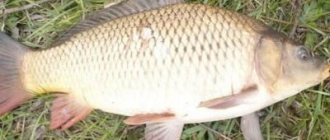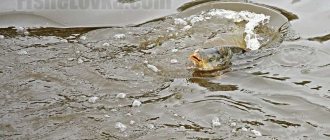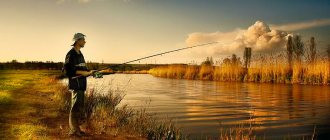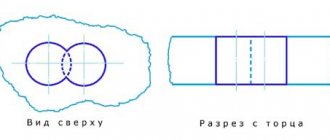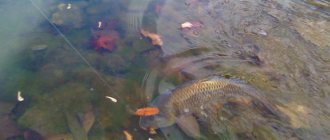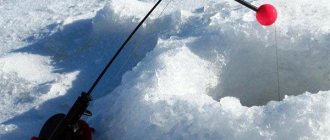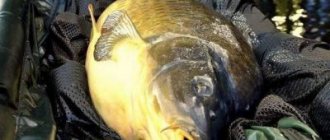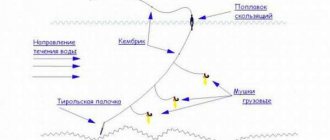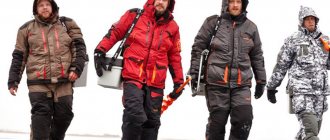Where to look for them?
If on the shelves of fishing stores there was a “fish seeing eye” with the exact coordinates of the location of a school of fish, as well as the degree of its activity in a particular body of water, then this would undoubtedly become a bestseller among fishermen. Yes, and every second person would start fishing, because under such conditions the catch is guaranteed. But until such a thing has been invented, we will use what we have.
The first thing that will help make your search easier is an echo sounder. It is enough to purchase a model with a minimum of functions and that will be enough. He will show you the thickness of the waters where the predator lives. In the absence of this device, teamwork can cope well with this task. What you should pay attention to when winter fishing:
Influence of natural factors
Particular attention must be paid to natural factors and artificial changes in water levels. It is worth considering that:
- with increasing pressure , the fish takes better over hummocks and hills, when the bait plays 40-80 centimeters above the bottom;
- when the pressure decreases - at depth, from the bottom;
- in strong winds the fish behave more actively than in calm conditions;
- When water is released, the fish rises into the water column and stands mainly above the riverbed or near it.
Read! Catching burbot on girders in winter
First ice
We fish closer to the shore, since the water temperature has not dropped much yet, and the fish have not yet had time to adjust to this period of time, which means they are still active. Deaf winter - we move to the depth/channel zones, since there the temperature remains comfortable, for most fish, 4-5 * C. With the moment of thaw, the place has to choose between the shore and the riverbed; fish from the pits go in search of oxygen, because in the pits it has already dried up.
The bottom and bottom layer are where the majority occur. Of course, it would be correct to work through all the layers, but pay the main attention to the bottom part.
It is advisable to decide on the desired object of fishing. At a minimum, the set of gear will depend on this. After all, what is good for one is not interesting for another. And everyone’s activity is different at different times. For example, when the ice becomes solid until mid-winter, you can successfully catch perch. From mid-winter to spring, roaches are roaches. Bream loves depth, but does not like to be disturbed. Therefore, it will be difficult to stumble upon their “parking lot”. You shouldn’t discount the preferences of fish; give fish like pike thickets with grass, but you won’t find pike perch in such a place during the day, give it either a clean bottom or driftwood.
Knowledge of the vegetation of the reservoir is a big plus. If a horsetail is caught on a hook, there is fish in this area; all that remains is to fish this area. But if you come across an elodea, you should leave the place, moving a hundred meters in any direction.
Exploring the coastline
Choosing a place to fish in winter always begins with studying the shore. If it is steep and steep, then the depths should be sought closer to the shore; if it is flat, then further away from it.
Even the nature of the vegetation on the shore matters. If a birch or pine forest borders on a low-growing forest, it means that nearby hard bottom soil is adjacent to soft one.
In general, the fisherman should look for border areas of the bottom where sandstone meets silt, vegetation with a clear place, a hill with a lowland, a flat section of a reservoir with a bay, a rocky ridge or ravine with a plain.
They are always attractive to fish, which, for example, prefer to stay on the sand and feed in the mud, where there are more bloodworms.
Such border zones should be fished first; this is where the fish concentrate. In winter, they can be identified by darker and lighter areas under the ice. Any changes in the bottom should attract your attention; fishing there will always be more successful than in homogeneous areas of the reservoir.
It has long been an established fact that the bite is better where there is a hill on a relatively flat section of the reservoir, where there are snags and large stones, on a steep slope of the bottom, which is directed towards the current.
If, after lowering the jig into the hole, you determine that you are in a place with a hole at the bottom, you know that you are in a place where fish feed.
Tackle
There is nothing to do on the ice with just a jig and a spinner, unless you are pursuing the goal: “just not at home.” After all, it’s not enough to find a fish; you need to interest it and activate it. And for this you must have no ace up your sleeve. Spoons, balancers, jigs, fishing line. All this should be available in different colors and sizes.
Changing the bottom from sand to stone, a layer below the rapids - all these are also good places for fish.
Of course, every fisherman has his own principles and secrets of finding good places in winter, but we still covered the main ones. By the way, it wouldn’t hurt to study your pond in the summer, which will make your search easier in winter.
What do you focus on when searching for fish in winter?
Happy fishing!
First things first: clothes for winter fishing
It is necessary to prepare in detail for this extreme activity. First of all, it must not allow moisture and wind to pass through, because the feeling of cold no longer arises from frost, but from the wind. A winter suit should consist of overalls and a jacket, comfortable and not restricting movement.
The most vulnerable places for winter catch lovers are the legs and back. Therefore, you need to take care of the warmth of these parts of the body. It is better to purchase special thermal underwear and socks made of dog hair that keep you warm. Now you can inexpensively buy special boots designed for fishing.
In addition to clothing, winter fishing enthusiasts need special equipment. In winter, some fish hibernate and it becomes more difficult to find them; for a successful catch, there are special gadgets.
An echo sounder is a device that examines sound impulses, helps to study the bottom topography, and locate fish. In winter, it must meet certain qualities: withstand low water and air temperatures, the ability to operate with gloves, and reaction to even the slightest fluctuations.
To protect from snow and piercing winds, you will need a tent for winter fishing. It is not necessary, but having a tent will make spending time on the ice more comfortable and enjoyable.
How to find fishing spots on the river
It is necessary to analyze each point so that all actions are distributed consistently and clearly. If you follow all the tips and recommendations, the catch will be guaranteed!
Even if there are not huge kilograms of fish caught or rare specimens, the chances of a good catch will be much higher than if a beginner in winter fishing senselessly walks along the shore in search of a good place.
Preparation is perhaps the most important stage before leaving or going fishing in the winter. It is necessary to find out as much information as possible about the reservoir where fishing is planned. This is where the Internet comes to the rescue. Read reviews, search for the name of a body of water and read about its nature, habitat, look at photographs taken by satellite, satellite maps will help you with this. Be sure to find out about the nearby gas stations, eateries and car service stations.
When arriving at a place - a body of water, do not rush to immediately step on the ice. You need to look around and evaluate the strength of the ice. You need to pay attention to the paths, footprints that go along the river - on the ice. If this is a small shallow river, you should pay attention to flooded trees and areas that are narrower in shape.
When you step on the ice, pay attention to the number of holes drilled and their location. You can use these “tips”, because they have already caught fish here. The more holes are made. The more likely it is that the bite here was clearly not bad.
So, the place has been found, the territory has been studied, which means... You should move on to the main steps - making holes. You can drill about 5-10 pieces. You can do this in a chess order, or simply along one visually drawn line. But this should be done so that the direction is from shallow to deep. This will give you more opportunities to fish at different depths and determine where the fish are at the moment. Multiple drilling will help you immediately immerse yourself in an enjoyable fishing process, and not be distracted by thoughts. What if you need to drill a couple more holes?
Preparation is important for the final choice of a future fishing spot. Spontaneity and chaos are unnecessary. It’s better to do everything according to a pre-developed scheme, and then just relax and enjoy the process itself.
Features of winter fishing at different times
In the fishing community, the cold season is usually divided into three stages: first ice, deep winter and last ice. The fact is that fish are caught differently in winter. If at the very beginning of freeze-up almost no one returns from reservoirs empty-handed, then in January most species almost completely stop feeding, and therefore stop pecking. Only the cold-loving burbot remains active, but it is quite difficult to catch it these days due to a sharp decline in the population. On winter fishing you have the opportunity to catch the following fish: ruff, perch, burbot, pike perch, and occasionally pike, bream and taimen, if they have not hibernated. However, the last listed species of fish bite very sluggishly and reluctantly. Let's see how the bite changes throughout the winter, and what problems anglers may encounter:
Winter fishing in the first ice is highly productive. At this time, most underwater inhabitants remain active and respond well to various baits, so the reservoirs are always full of people. But in late autumn and at the very beginning of winter, the ice is not yet strong enough and poses a serious danger. It is during this period that the pick can become that lifesaver that will help you confidently reach a promising place.- Winter fishing in the wilderness is not unreasonably called the low season. The fish becomes passive, catches much worse, and in some reservoirs shows no signs of presence at all. But this does not stop fishermen, because in winter you get pleasure from even catching two or three small fish. But you can walk on ice calmly, without fear of falling through.
- Winter fishing on the last ice is something that fishing enthusiasts look forward to with great impatience. As spring approaches, the bite becomes more active again, the fish slowly emerges from its half-asleep state and begins to delight with confident bites more and more often. But as the temperature rises, the risk increases as the ice becomes not only thin, but also loose. One careless step and a person ends up in the water. Therefore, you should behave extremely carefully on a pond.
Winter fishing is a great way to dispel the blues and get rid of the depression that besets people at this time of year. It is not surprising that in winter you can see hundreds of fishermen on reservoirs, “casting spells” over their holes. If you are not one of them yet, join us!
Sweden, Tornio river
worldfishing.ru/spetspredlozheniya/sweden-ice
Who to catch:
trout and grayling, trophy pike and large perch, lake char and whitefish.
When to go:
from March to April.
Tour:
five nights, four days of guided fishing. The small and cozy chalets of the Rajamaa fishing camp are located on a small island right in the middle of the river. Guests are offered full board: breakfast and dinner in the restaurant, a hot camp lunch while fishing, plus a Finnish sauna. Every day you will fish for six hours on different ice lakes on both sides of the Swedish-Finnish border.
Price:
from 68,000 rubles, including transfers from/to Kittila or Rovaniemi airports. The program does not include drinks and transportation to the camp. You need to bring your own gear, but they will provide you with warm clothing.
Bosnia, Una river
eklev.ru/bases/lovlya-tajmenya-v-bosnii-na-reke-una.html
Who to catch:
Danube taimen, brook trout, grayling.
When to go:
the season is open from June to February, but the best time is November and December.
Tour:
seven days, six of which are full board and fishing. They will meet you at the airport in Zagreb or Belgrade. By the way, entry is visa-free. The cottage with all amenities and three meals a day will be located on the very bank of the Una River. The place is quiet, almost remote, in the only town on this river there is a shop and a couple of restaurants. The landscapes around will be picturesque - a powerful river, islands, rocks... Fishing is a pleasure! The guide will show and tell you how and what baits are best to catch this or that fish.
Price:
from 41,000 rubles with mandatory support, all necessary licenses, transfers.
